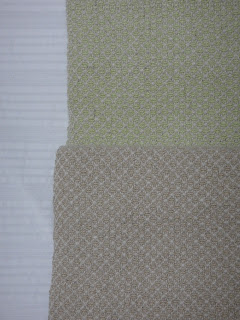For
this project, I decided to make napkins using two colors of weft on the same
warp. Using ivory cottolin warp set at
24 ends per inch, I wove two lengths of the same pattern using tan weft and
light green weft. Unlike some of my
previous twill experiments, this time I used a floating warp to ensure a neat
selvedge, which was a big help.
Learnings:
- Floating warps really do make a huge difference! My selvedges not only are free of the weird floaters I was getting on the Greenland twill, but they are much more even. It took some getting used to and slowed me up a bit at first, but once I got used to working with them it was worth the extra effort.
- Patterns like this are far less forgiving of mistakes in tredling than plain twill. You can see every little mistake. My usual strategy of warping up twice what I actually needed too to get two usable napkins proved to be a good one here, as I had quite a few tredling mistakes at the beginning.
- I need to do some work on color combining. I was surprised that the tan and cream pattern had better contrast that the green and cream. This is not at all what I would have thought would have happened. I suspect that doing white-on-white would have a better effect that I had initially thought as well, given how nicely the cream/tan combo came out which bodes well for my Perugia project.
Bender-Jorgensen,
Lise. North European Textiles until AD. 1000. Aarhus
University Press (December 1992)


No comments:
Post a Comment